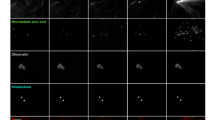Abstract
Mitotic and meiotic spindles consist primarily of microtubules, which originate from centrosomes and within the vicinity of chromatin. Indirect evidence suggested that microtubules also originate throughout the spindle, but the high microtubule density within the spindle precludes the direct observation of this phenomenon. By using meiotic Xenopus laevis egg extract and employing total internal reflection (TIRF) microscopy, microtubule nucleation from preexisting microtubules could be demonstrated and analyzed. Branching microtubule nucleation is an ideal mechanism to assemble and maintain a mitotic spindle, because microtubule numbers are amplified while preserving their polarity. Here, we describe the assays that made these findings possible and the experiments that helped identify the key molecular players involved.
Access this chapter
Tax calculation will be finalised at checkout
Purchases are for personal use only
Similar content being viewed by others
References
Lajoie-Mazenc I, Tollon Y, Detraves C, Julian M, Moisand A, Gueth-Hallonet C, Debec A, Salles-Passador I, Puget A, Mazarguil H et al (1994) Recruitment of antigenic gamma-tubulin during mitosis in animal cells: presence of gamma-tubulin in the mitotic spindle. J Cell Sci 107(Pt 10):2825–2837
Mahoney NM, Goshima G, Douglass AD, Vale RD (2006) Making microtubule sand mitotic spindles in cells without functional centrosomes. Curr Biol 16:564–569
Brugues J, Nuzzo V, Mazur E, Needleman DJ (2012) Nucleation and transport organize microtubules in metaphase spindles. Cell 149:554–564
Loughlin R, Heald R, Nedelec F (2010) A computational model predicts Xenopus meiotic spindle organization. J Cell Biol 191:1239–1249
Goshima G, Wollman R, Goodwin SS, Zhang N, Scholey JM, Vale RD, Stuurman N (2007) Genes required for mitotic spindle assembly in Drosophila S2 cells. Science 316:417–421
Goshima G, Mayer M, Zhang N, Stuurman N, Vale RD (2008) Augmin: a protein complex required for centrosome-independent microtubule generation within the spindle. J Cell Biol 181:421–429
Uehara R, Nozawa RS, Tomioka A, Petry S, Vale RD, Obuse C, Goshima G (2009) The augmin complex plays a critical role in spindle microtubule generation for mitotic progression and cytokinesis in human cells. Proc Natl Acad Sci U S A 106:6998–7003
Lawo S, Bashkurov M, Mullin M, Ferreria MG, Kittler R, Habermann B, Tagliaferro A, Poser I, Hutchins JR, Hegemann B, Pinchev D, Buchholz F, Peters JM, Hyman AA, Gingras AC, Pelletier L (2009) HAUS, the 8-subunit human Augmin complex, regulates centrosome and spindle integrity. Curr Biol 19:816–826
Petry S, Groen AC, Ishihara K, Mitchison TJ, Vale RD (2013) Branching microtubule nucleation in Xenopus egg extracts mediated by augmin and TPX2. Cell 152:768–777
Castoldi M, Popov AV (2003) Purification of brain tubulin through two cycles of polymerization-depolymerization in a high-molarity buffer. Protein Expr Purif 32:83–88
Hyman AA (1991) Preparation of marked microtubules for the assay of the polarity of microtubule-based motors by fluorescence. J Cell Sci Suppl 14:125–127
Gell C, Bormuth V, Brouhard GJ, Cohen DN, Diez S, Friel CT, Helenius J, Nitzsche B, Petzold H, Ribbe J, Schaffer E, Stear JH, Trushko A, Varga V, Widlund PO, Zanic M, Howard J (2010) Microtubule dynamics reconstituted in vitro and imaged by single-molecule fluorescence microscopy. Methods Cell Biol 95:221–245
Aitken CE, Marshall RA, Puglisi JD (2008) An oxygen scavenging system for improvement of dye stability in single-molecule fluorescence experiments. Biophys J 94:1826–1835
Petry S, Pugieux C, Nedelec FJ, Vale RD (2011) Augmin promotes meiotic spindle formation and bipolarity in Xenopus egg extracts. Proc Natl Acad Sci U S A 108:14473–14478
Kalab P, Weis K, Heald R (2002) Visualization of a Ran-GTP gradient in interphase and mitotic Xenopus egg extracts. Science 295:2452–2456
Groen AC, Maresca TJ, Gatlin JC, Salmon ED, Mitchison TJ (2009) Functional overlap of microtubule assembly factors in chromatin-promoted spindle assembly. Mol Biol Cell 20:2766–2773
Albee AJ, Wiese C (2008) Xenopus TACC3/maskin is not required for microtubule stability but is required for anchoring microtubules at the centrosome. Mol Biol Cell 19:3347–3356
Murray AW (1991) Cell cycle extracts. Methods Cell Biol 36:581–605
Hannak E, Heald R (2006) Investigating mitotic spindle assembly and function in vitro using Xenopus laevis egg extracts. Nat Protoc 1:2305–2314
Desai A, Murray A, Mitchison TJ, Walczak CE (1999) The use of Xenopus egg extracts to study mitotic spindle assembly and function in vitro. Methods Cell Biol 61:385–412
Edelstein AD, Tsuchida MA, Amodaj N, Pinkard H, Vale RD, Stuurman N (2014) Advanced methods of microscope control using muManager software. J Biol Methods 1(2), pii: e10
Rasband WS (1997/2014) ImageJ, U.S. National Institutes of Health, Bethesda, MD, USA, http://imagej.nih.gov/ij/
Acknowledgements
This work was supported by grants from the NIH/NIGMS (4R00GM100013), the Pew Scholars Program in the Biomedical Sciences, the Sidney Kimmel Foundation, and the David and Lucile Packard Foundation to S.P.
Author information
Authors and Affiliations
Corresponding author
Editor information
Editors and Affiliations
Rights and permissions
Copyright information
© 2016 Springer Science+Business Media New York
About this protocol
Cite this protocol
King, M., Petry, S. (2016). Visualizing and Analyzing Branching Microtubule Nucleation Using Meiotic Xenopus Egg Extracts and TIRF Microscopy. In: Chang, P., Ohi, R. (eds) The Mitotic Spindle. Methods in Molecular Biology, vol 1413. Humana Press, New York, NY. https://doi.org/10.1007/978-1-4939-3542-0_6
Download citation
DOI: https://doi.org/10.1007/978-1-4939-3542-0_6
Published:
Publisher Name: Humana Press, New York, NY
Print ISBN: 978-1-4939-3540-6
Online ISBN: 978-1-4939-3542-0
eBook Packages: Springer Protocols




